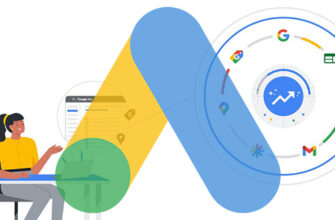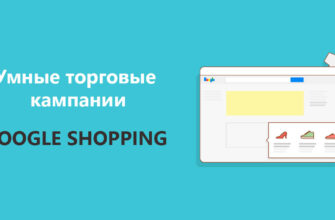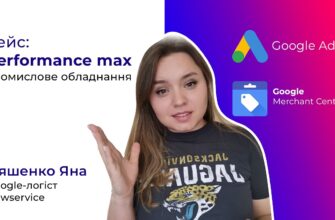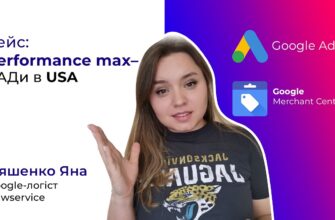- Briefly about the case under consideration, what the client came with
- Difficulties encountered in work
- Why is it difficult to promote a product on the European market?
- Help: what is Performance Max?
- Target conversions were deleted by the client
- We don’t see all conversions due to payment methods in Shopify
- Problem with delay in displaying conversions by Google
- The work we have done and the results, taking into account the indicated difficulties
- Why wasn’t it possible to scale quickly?
- Work carried out to achieve this level of conversion
- Testing different structures
- Testing different strategy options
- Testing a large volume of signals
- Difficulty of working with pure traffic
- Remarketing lists narrowed their reach
- Some products prevent performances from scaling
- Results
Hello everyone. My name is Yana Lyashenko, Google logistics specialist. I am engaged in delivering business to the target audience with the necessary parameters. This means that I know how to find a target audience, bring them to the site, and use this to scale online sales.
Briefly about the case under consideration, what the client came with
In today’s video I would like to demonstrate one of the cases, or rather, one case. It seems that the level of difficulty is average, but not the most difficult. Not the lightest and not the easiest in terms of quick and adequate response to scaling.
Today we’ll look at an online store. The topic, let’s call it children’s products to maintain client confidentiality in a highly competitive environment. What do we have? We have an online store. Promotion country: Germany. A client came with a request that there were few sales, they could not break through the ceiling in their volume. We need to somehow deal with this in the overall dynamics.
How many calls and sales will I get by ordering contextual advertising from you?
I need to calculate the conversion of my website Describe
the task
in the application
Calculate potential ad revenue Google
contextual advertising calculator
I’ll compare the period, for example, May, when he came to us. Although May was already subsiding towards the end. The last 30 days are October, from October 24 to November 22, directly. You can see the volume of conversions in the screenshot.
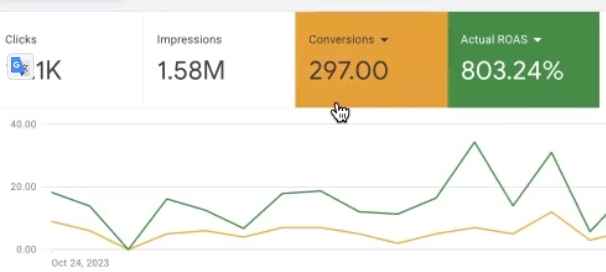
All registered purchases. There are much more purchases in reality. Why are there more of them? This is the Shopify platform. It uses the Shopify payments payment system and one of the Shopify payments payment options; unfortunately, some conversions are not recorded as purchases. Anyway. And you can see here Actual ROAS, but clicks, Impressions. I don’t know if they are needed conditionally or not. You can only add to show the correlation that traffic volumes are sometimes not particularly correlated with conversion volumes.
Difficulties encountered in work
And so. What the client came with is relatively clear. We need to increase the number of conversions of a certain type. What difficulties did you encounter? Well, first of all, increase sales using regular trade advertising campaigns. In general, for an online store, the market is, for example, Germany. What types of advertising campaigns can you run on Google? There is a small selection of options: search, display display, banner advertising, YouTube ads and Google Shopping itself. For the majority, for nine out of ten stores, the main source of revenue in turnover and conversions will begin to come only from Google Shopping. Everything, 60 percent or more, will begin to generate turnover. These are well-promoted trade advertising campaigns. Everything else seems to be adding, but not fundamentally determining.
In this case, the client has already arrived with advertising campaigns running. As I said, there are two formats for Google shopping. These are regular shopping advertising campaigns and smart shopping advertising campaigns called Performance Max. I think you’ve heard of them. So what’s the difficulty? Regular trade advertising campaigns were quite difficult to sell.
Why does this happen and is it so difficult to download Performance Max? I’ll explain now.
Why is it difficult to promote a product on the European market?
What is the difficulty of promoting in the European market? First, Europeans are slow to buy. Let’s say, take the American or Ukrainian market, where you conventionally came, saw and bought, an impulsive purchase or some kind of purchase, here and now, when there is a need, extended over time. The Germans also take a certain period of time, this is from two to three days, so that they can immediately get their bearings; during this period, people still interact with the site. The procedure for obtaining a sale extends for at least three and seven days. Some people achieve conversions. Plus, another number of interactions is added not only with the site, but also with other competitors.
You need to fit into a certain or obtained ROAS, profitability, or conversion volume. You need to fit in for there to be a result, directly. That’s right, what we can’t do is not Bill Gates, what he’s ready to give… Bill Gates is not ready to give all the money to Google to get sales. Right?
There are restrictions within which this story must be directly worked out. This is a definite limiting factor in the growth rate of any smart campaign performance in terms of conversion volumes. Here we started, relatively speaking, again from scratch. There was a fairly specific set of problems in the account and the goals were removed. Before I begin to describe the problems and how to deal with them, I will describe the general picture.
Help: what is Performance Max?
Performance Max – what is it? Here the scaling goes to Performance Max. Conventionally, smart campaigns that use Google artificial intelligence to find the target audience. What does it mean? This means that when we take a story about artificial intelligence, this is a system that can work, process, analyze and output results for further use based on a certain database. For an advertising account, the database is analytics or user behavior when purchasing, has already purchased, or if he has performed some micro-actions on the site, but these micro-actions precede the purchase. The larger the statistical sample, the more it is in the account, the higher the likelihood that subsequent iterations of edits or adjustments in the account will lead to certain events. Here it is for sale, making money, directly for the client. Agree, everything is quite simple in this context.
What do we have here? We need to collect this database and give it to Google. There is a widespread opinion on the Internet that you need to create this advertising campaign, Performance Max, and just give it a waiting period. Next I will show a set of advertising campaigns for tests, carried out in different periods of the months of the twenty-third year, just to get closer to the current result. If we take an approximate structure in another country, but with smaller conversion volumes, but with different test options, the result there is significantly less.
Just giving Google’s artificial intelligence a waiting period for some miracle is, a priori, not true in the context of Google Ads. Well, from practice, this project has definitely been tested, since several countries have been launched.
Target conversions were deleted by the client
Next. What are the difficulties? Firstly, target conversions were removed from the account and the process of tracking them was disrupted. Well, it doesn’t matter how it happened. The question is that we had to return it and, accordingly, what was removed is not always just on/off, as happens with light. Sometimes it produces certain consequences on the advertising account and on the database used by the intelligence.
We don’t see all conversions due to payment methods in Shopify
Secondly, most of the payments are made through Shopify payments and, accordingly, part of the conversion is not visible. We see only part of the conversions.
Problem with delay in displaying conversions by Google
The third thing is that Google itself delays conversion analytics in your account. I will show this analytics for the last 30 days and the analytics are deceptive. In reality, there are even more conversions and the profitability is higher than the values that you will see in the profitability column. Why is this happening? Unfortunately, Google doesn’t really allow you to see information more quickly than you would like. I would like it to be 24/7, but it loads at least 72 hours late.
The work we have done and the results, taking into account the indicated difficulties
What is the difficulty? Some things were removed, the database was changed to work with artificial intelligence. The second was that if it is not easy enough to return it and not disturb the performance. Over a short period, it seems since June of twenty-three, a bunch of tests have been carried out on different performance structures to achieve these results. There are currently 297 purchases. ROAS is actually shown to be 803 percent. This is an even smaller result in fact. Less than Google will recalculate in 3 days. Conversions are on the rise just before Black Friday.

It can be seen that on Sunday, November 19, there were 33 purchases. Profitability is 1500%. The profitability in columns is significantly less. There are 16 sales here. There are 11 here. This is a comparison with the four, five a day that were before. End of october. We have five sales, or seven sales.

And when we just started working with a client in June, even five sales a day were achieved, well, with great stretch. Didn’t allow scaling fast enough.
How many calls and sales will I get by ordering contextual advertising from you?
I need to calculate the conversion of my website Describe
the task
in the application
Calculate potential ad revenue Google
contextual advertising calculator
Why wasn’t it possible to scale quickly?
Why didn’t it allow you to scale quickly? There are several reasons. First, the length of the purchasing process. You can conditionally cover everyone starting the purchasing process, for example, the first day, the second day. Concentrate only on those closest to the third day of purchase.
Where do I get these numbers? Google itself, based on the collected analytics, can roughly draw. Now I’ll show you the report. Okay, not everything is perfect, not presentable analytics. There will be 1.3 conditional days. Before this, there was much more in the period. And 2.5 interactions per iteration before converting.
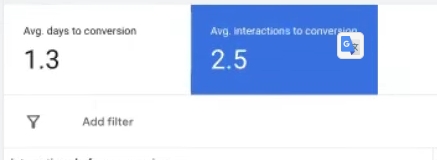
For example, this report shows that 16 purchases were made in five interactions with the site. Each interaction costs a certain amount of money. Each interaction within days also costs a certain amount of money. There’s no escape.
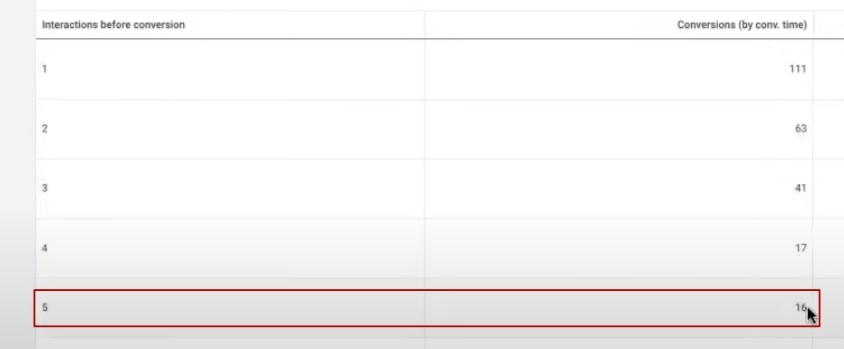
And it turns out that if we simply reach everyone in a row, we will end up with expensive advertising; if we do not reach some of the guys who are already close to the conversion stage, it turns out that we will not complete this cycle. According to their losses. Working with Performance Max is both exciting and interesting. But it can be difficult, because, firstly, you don’t get sufficient analytics from hour to hour. And you actually need to track your changes with some kind of post-period.
Secondly, I don’t recommend simply leaving Performance Maxes in peace, just waiting for a period of some kind of waiting, and this should lead to some kind of result. Visible without deleted 42 Performance Max campaigns. Now, of course, there are some left… Now I’ll tell you which quantities are included. How many are included? 20 pieces. Yes, 20 advertising campaigns included. There are also new ones in the test. Not everyone results in conversions equally proportionately. Not everyone produces the same proportional result in profitability, conditionally.
Work carried out to achieve this level of conversion
Testing different structures
What should we pay attention to? What did you do to approximately achieve at least a similar volume of conversions? The first is testing different filling structures for the Performance Max product. Yes. One campaign for all products is not enough. Some of the goods were profitable. Some simply spent money, bringing absolutely nothing. This is a problem.
Testing different strategy options
Second. Testing different bidding strategies. There are advertising campaigns for one product item that work for profitability, not for maximum conversions. Profitability here turned out to be the most optimal strategy, in principle, for starting any advertising campaign, regardless of structure.
Second, at the moment there are only two campaigns that have an object filled with texts, pictures and videos. All other advertising campaigns are absolutely without filling. They only target Google Shopping format directly, stalking, or Shopping Search targeting.
Testing a large volume of signals
Next, this is a test of a fairly large volume of signals. There are advertising campaigns that have absolutely no signal. There are advertising campaigns that contain a certain set of signals. Let’s take the first campaign in terms of conversion volume. If we go to Assets groups, we will roughly see a picture that is a signal for our date. Let’s take a campaign that simply targets Black Friday with merchandise. A campaign without signals and, if you look at the approximate result, gave 16 conversions directly.

There is one advertising campaign without a signal. Campaigns that are focused on one product item simply work for profitability even without a signal. For a rough understanding of the test options. Various combinations of signals, options. Also, the most resource-intensive and, as a result, scalable option turned out to be a test of various product combinations. What is the difficulty? If we launched one campaign, some of the products or product groups turned into conversions, while others simply clicked together. When they simply pulled out a set of products into a separate performance, they did not always turn into conversions.
We developed a specific test for different options for mixing different types of goods with each other, in order to catch something specifically that will convert. Since products are for children, sometimes the not obvious can bring conversions.
Difficulty of working with pure traffic
More. The paradox in selling these products is that in regular Google shopping campaigns, the traffic is as pure as possible in performances. If we separate a separate product category into a separate performance, the traffic is as targeted as possible.
There is a product name and the request goes directly specifically to the product, there is no movement, etc. Which is also difficult, since simply adding the name of the goods to the signals, for example, does not allow, conditionally, to increase the number of sales.
Remarketing lists narrowed their reach
Also, simply adding remarketing lists as a targeting method sometimes narrowed the reach and did not allow growth in conversions. But these lists are useful, in principle, for scaling, if there is some kind of analytics. Be careful with them.
Some products prevent performances from scaling
Another difficulty turned out to be that there were product positions that attracted the main turnover, but due to the general dynamics of the lists for those that made conversions, they had slightly different characteristics from the people who needed them, from the people who could buy other products categories. This made it a little difficult for other performances to scale up.
This is a whole set of different targeting options, what to test here in order to simply stabilize sales. Due to the fact that some conversions could arrive in the advertising account late, advertising campaigns were sometimes turned off, which turned out to be unprofitable. In fact, the profitability is higher. As now, for example, we can see statistics for 30 days. It appears that the volume of conversions and profitability are much lower here. Lower than in fact after about 3 days. Analytics will be recalculated. Sales are actually much higher, since a portion of sales are not taken into account through Shopify payments and profitability will be higher. It will be recalculated and counted, conditionally.

Results
I would call the case medium in complexity, closer to the most complex. There is no simple structure where I created an advertising campaign and it definitely started dancing right away. There are resources for improvement when it is necessary to improve, for example, the same profitability in some categories, since only campaigns, for example, have begun their journey of work. Like this advertising campaign. She is just beginning her journey. Its profitability is still rather low and, accordingly, everything needs to be dealt with and these performances need to be directed in a certain direction.
I would like to emphasize that the project is not easy. Difficult. Difficulties come from different sides and formats. This includes certain things that hinder further growth. It’s not always possible to simply scale using advertising campaign budgets. There are so many Performance Max, different tests being done, structure and signal tests, just to stabilize this thing.
I think that by the New Year’s sale we will grow stronger and accumulate more useful data, a database for performances. For easy passage of the period of no longer seasonal sales in January.
This is roughly the kind of case where you can’t see a sharp upward mountain. You don’t see any super cool ones, 2000 to 3000 percent profitability. There are no 1200 sales here. I think we’ll reach 1200 sales in a month. There are analytics collected piece by piece, piece by piece, which turns into a certain volume. The turnover that we have. There is hope that over the next period we will increase it a little.









